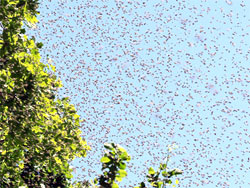
By Sherman Shifflett
During the 1940’s-50’s, wild honeybees were plentiful. They could be seen in pastures with clover, flower gardens, orchards, or anywhere there was available nectar. Creeks and water holes were other places the bees frequented.
Dad was always able to find “honey trees”, where the wild honeybees built their hives. I remember one occasion in Covesville when Dad and some neighbors raided a wild beehive. I was too small to tag along, but I recall that they went on a Saturday night and brought honey home on Sunday morning. The honey was brought home in buckets. The wild honey was darker than homegrown honey or commercial honey. The waxy comb was also dark.
How was the honey collected? I don’t exactly know. I recall Dad once saying, “We smoked ’em out”, when asked about the bees. Obviously, smoke was used, but Dad never told me too much about the process of gathering wild honey, and I never got the opportunity to observe.
Although I was too young to accompany the group on the honey raids, I did go to the creek with Dad several times to watch the honeybees. This was usually done on early mornings.
Numerous bees would be around the water, and when they left, they would fly straight up, circle a few times, then take off in a straight line – a “bee line”, if you will. We watched several bees take off, and if enough went in a particular direction, Dad knew where to start hunting. Dad also noted that, based on his experience, many bee trees were fairly close to water.
It was a challenge to Dad to find the “bee trees”, but one that he enjoyed. Sometimes he would take some of us along as he searched. When he found trees with wild beehives, he would return periodically and check on them. I went bee-tree hunting with him a few times, but I never found one
I recall another time when Dad and I were in the woods, about 30-40 yards apart, Dad stopped, called me over and pointed up a tree.
There was a dark cluster of bees hanging on a limb. A big, dark blob. A few were buzzing around. Dad said they were swarming.
When I asked what that meant, he said that sometimes bees break off from their hive, sometimes because of over-crowding. Then, they leave the hive with a queen to find a new place to set up housekeeping. Swarming happens in the spring because the new hive needs time to build a food supply to survive the winter.
Today, bee populations are threatened, but it seems to me that there were once more bee trees in the Blue Ridge Mountains than here. I am, however, seeing some in my yard, which has lots of clover.
Some say that wild honey is better than homegrown or store bought honey. All I can remember, it was dark, it was sweet and it was delicious.

